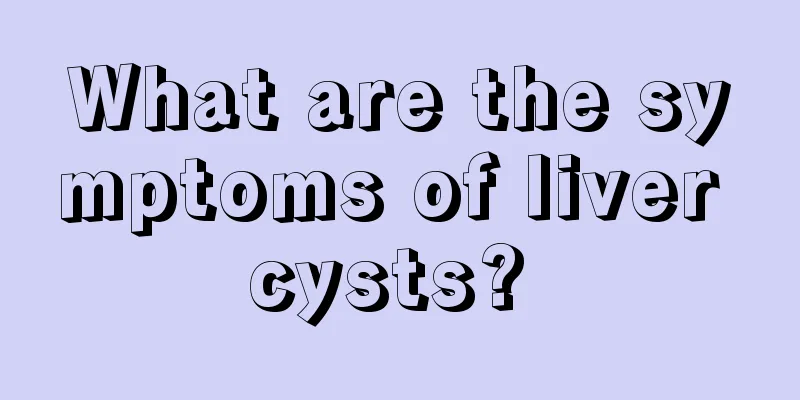What are the symptoms of liver cysts?

|
The liver is one of the important organs of the human body. If liver cysts occur, it will have a great impact on the patient's health. Patients will experience more obvious symptoms, such as nausea and vomiting, loss of appetite, jaundice, abdominal pain, etc. These symptoms may cause severe discomfort to patients, so patients can still discover them in time and should seek medical examination and treatment in time. Liver cysts may be asymptomatic for a long time or for life due to their slow growth and are often discovered accidentally during B-ultrasound examination. The main clinical manifestations vary with the location, size, number of the cysts, whether they compress adjacent organs, and the presence or absence of complications. Simple liver cysts are relatively rare, and occur more often in females than in males, with a male-to-female ratio of 1:4. About 20% of patients have symptoms. The most common initial symptom is an increase in abdominal circumference. The initial symptoms can begin at any age, but most often occur between 20 and 50 years old. Other common clinical symptoms and signs are as follows: 1. Gastrointestinal symptoms When the cyst enlarges and presses on the stomach, duodenum, and colon, it can cause symptoms such as fullness after meals, loss of appetite, nausea, and vomiting. 2. Abdominal pain Large, heavy cysts may cause distending discomfort, dull pain, or mild, dull ache in the upper abdomen. Sudden onset of severe pain or symptoms and signs of peritonitis may indicate complications such as cyst bleeding or rupture, and may also cause chills and fever. 3. Abdominal mass The discovery of an abdominal mass is the primary initial presentation in many patients. 4. Jaundice Cysts near the porta hepatis that compress the hepatic duct or common bile duct can cause mild jaundice, which occurs less frequently, in only about 5% of cases. 5. Physical examination The main sign is a mass felt in the abdomen that moves with respiration. The mass has a smooth surface and is usually hard, only partially cystic and fluctuating. Its location depends on where the cyst occurs, but most are located in the right upper abdomen. examine 1. B-mode ultrasound Type B ultrasound examination for diagnosing liver cysts has the advantages of high sensitivity, non-traumatic, simplicity and ease. Cysts <1 cm are also easy to detect with an accuracy rate of 98%. It can also determine the nature, location, size, number of cysts and the extent of liver involvement, making it the preferred examination method for this disease. The sonographic image of liver cysts shows round or oval liquid dark areas in the liver, with thin cyst walls, neat and smooth edges, and clear boundaries with surrounding tissues. The echoes of the posterior wall of the cyst and deep tissues are enhanced, and the wall is often accompanied by refracted acoustic shadows. 2. CT scan CT examination can accurately show the location, size, range and nature of liver cysts, with a diagnosis rate of 98%. On CT scans, liver cysts appear as round or elliptical low-density areas with clear boundaries and uniform density, and show no enhancement after intravenous contrast imaging. |
>>: What are the symptoms of corpus luteum cyst?
Recommend
Can washing your hair with salt water treat hair loss? Does it have any other effects?
For many female friends, many people will experie...
The most important clinical manifestations of patients with colon cancer
There are many intestinal cancer diseases, and co...
Azithromycin for nephritis
Azithromycin is a drug that can be used to treat ...
What should I eat before getting on a car if I get carsick?
Motion sickness is a very disappointing thing for...
Eating too many apricots has so many negative effects
Apricots are extremely rich in nutritional value,...
What are the methods to prevent cervical cancer
Among all cancers, only cervical cancer can be ef...
Is it necessary to get the chickenpox vaccination?
The chickenpox vaccination is definitely necessar...
Will renal hamartoma disappear?
Renal hamartoma is a benign tumor. Nowadays, this...
Don’t put soy milk in a thermos cup. Things to note when drinking soy milk
The weather is cold and everyone has started usin...
Who are suitable to wear large frame glasses
Nowadays, large-frame glasses have become very po...
An optimistic attitude helped him get out of the shadow of meningioma
In 1999, due to an epileptic seizure, 19-year-old...
Is it okay to wean my baby at three months old?
When the baby is three months old, if his physica...
How long does liver cancer interventional surgery take?
How long does liver cancer interventional surgery...
Why does chickenpox cause sunken scars
The hot summer is coming soon, which makes many p...
What causes liver cancer in young people? To prevent liver cancer, you need to avoid four things
Liver cancer can have a great impact on many aspe...









